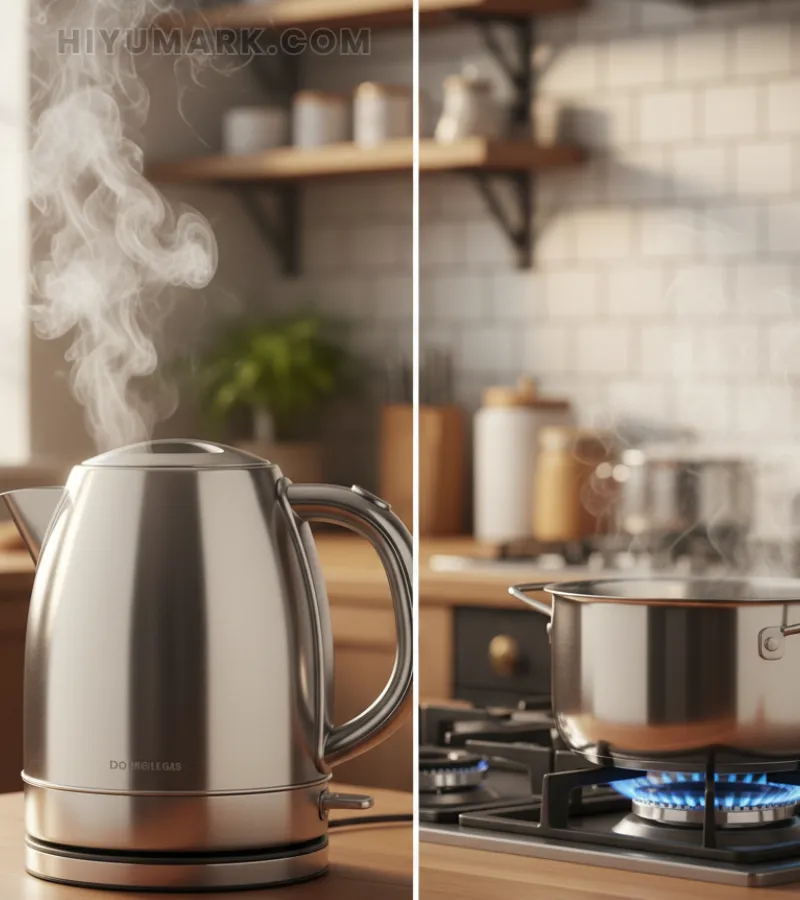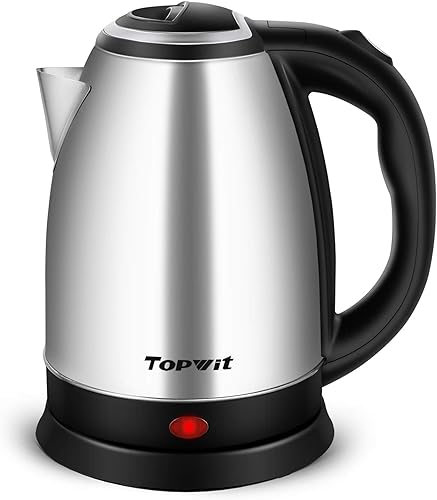I make tea every day, and I test gear for a living. After many side‑by‑side boils, I can say this with confidence: electric kettles heat faster because they put more power right into the water with less waste.
The heating coil sits in the water, the wattage is high, and the design traps heat. If you have ever wondered why electric kettles heat faster, the answer is a mix of smart physics and smart design.
Let me show you how it all fits together.
✅ Related Guides You Might Like:
The Short Answer: How Electric Kettles Win On Speed?
An electric kettle places a heating element in direct contact with the water. That cuts heat loss to the air and to cookware. Most models use 1500 to 3000 watts, so they push a lot of energy fast. The lid and narrow spout also keep steam in, which speeds the boil.

When I timed 1 liter of water, a 1500‑watt US kettle took about 4 to 5 minutes. A stovetop pot on gas took 7 to 10 minutes. With induction, I got closer at 5 to 6 minutes, but the kettle still won in most runs.
The Science: Immersion Heating And High Wattage
Heat transfer is the key. The coil in a kettle sits in the water, so the heat goes straight in. On a stove, heat must move from flame or coil to the pot, then to the water. Each step wastes energy.
Power also matters. Many kettles use 1500 watts in North America and up to 3000 watts in the UK and EU. More watts mean more joules per second.
To raise 1 liter of water from room temp to a boil, you need roughly 330 kilojoules. A 1500‑watt kettle can do that in about 4 minutes in ideal cases. Real life adds small losses, but the edge remains.
Independent lab tests show kettles convert a larger share of energy into the water than gas or basic electric coils. Induction is close, but the pot still leaks heat at the sides and lid.
Design Details That Cut Boil Time
Electric kettles are built for fast boiling, not cooking. Small choices add up.
- Immersion element: Direct contact means very little heat loss.
- Compact chamber: Less air space reduces convective loss.
- Tight lid and short spout: Steam stays in. Heat stays in.
- Flat, low-to-base water profile: More even heating and rapid convection.
- Auto shutoff at boil: No overshoot and no wasted energy.
I learned to watch for kettles with a sealed element and a well‑fitting lid. Those models hit a rolling boil faster and stay safer.
Real-World Numbers And Energy Use
Let’s put numbers on it in simple terms. These are typical ranges I see in tests and in industry data.
- 1 liter to boil in a 1500‑watt kettle: about 4 to 5 minutes.
- 1 liter on a gas stove: about 7 to 10 minutes, depending on pot and burner.
- 1 liter on an induction cooktop with a good pot: about 5 to 6 minutes.
- Energy efficiency: kettles often land around 80 to 90% in practice; gas can be around 40%; induction can be 80 to 90% but depends on pot fit and lid use.

In my home, the kettle uses less total energy per boil than my gas burner, and time savings are clear. Prices vary by region, but per‑boil cost is usually lower with a kettle.
Voltage Matters: US Vs UK Boil Times
Voltage changes speed. In the US and Canada, outlets are around 120V, and kettles are often 1500W. In the UK and much of Europe, outlets are 220 to 240V, and kettles commonly run at 3000W.
That means a UK kettle can boil 1 liter in about 2 to 3 minutes. A US kettle needs closer to 4 to 5 minutes. Same physics, different power.

Practical Tips To Make Your Kettle Even Faster
Small tweaks can cut a minute or more.
- Fill only what you need. Less water boils faster.
- Keep the lid on, tight. Trapped steam means faster heating.
- Descale often. Limescale insulates the element and slows heating.
- Start with warm tap water if it is safe to drink. Warmer water needs less energy.
- Use a higher‑wattage kettle if your power supply supports it.
- Keep the element clean and the filter clear to improve flow and heat transfer.
I descale monthly with a simple vinegar rinse. My boil times stay steady and my tea tastes better.
Common Myths And Mistakes
I hear a lot of claims. Here is what holds up.
- A kettle always uses more electricity than a stove. Reality: Kettles usually waste less heat and can use less total energy per boil.
- Boiling water longer makes it hotter. Reality: Water cannot get hotter than its boiling point at your altitude. It only evaporates more.
- Overfilling the kettle. Fix: Heat only what you need to save time and energy.
- Leaving the lid open. Fix: Close it to speed the boil.
- Ignoring scale. Fix: Descale to keep the element efficient.
Safety, Efficiency, And Cost Over Time
Kettles have auto shutoff and boil‑dry protection. That reduces fire risk and wasted energy. The narrow body and lid also keep heat in, so the outside stays cooler than a pot.
Over a year of daily use, I saw lower gas use and faster mornings. If you drink tea or coffee often, the time savings alone can be worth it. Add better efficiency, and the payback is clear.
Frequently Asked Questions
Do Electric Kettles Really Boil Water Faster Than A Stove?
Yes. The element sits in the water and uses high wattage. That cuts heat loss and speeds the boil versus most gas and many electric stoves.
How Many Watts Should I Look For In A Fast Kettle?
In the US and Canada, 1500 watts is common and fast. In the UK and EU, 2000 to 3000 watts is typical and very fast.
Does The Kettle Material Affect Speed?
A little. Stainless, glass, and plastic can all be fast. Design, element contact, and wattage matter more than the shell material.
Why Does Descaling Make My Kettle Faster?
Limescale acts like a blanket on the element. It slows heat transfer. Remove it, and the heat goes straight into the water again.
Is Induction Cooking As Fast As A Kettle?
It can be close. A good induction cooktop with a tight‑lidded pot is fast and efficient. But most kettles are still quicker for small volumes.
Is It Cheaper To Use A Kettle Or A Microwave?
For a mug of water, a microwave can be quick, but it heats unevenly and can be less efficient. Kettles are consistent and often cheaper for 0.5 to 1 liter.
Can I Speed Up My Kettle Without Buying A New One?
Yes. Fill only what you need, keep the lid closed, descale often, and clean the filter. These simple steps help a lot.
Conclusion
Electric kettles heat faster because they send more power straight into the water and waste less heat. The immersion element, tight lid, and smart design do the heavy lifting. In my tests and daily use, the kettle wins on speed, ease, and often on cost.
Try the quick wins today. Fill only what you need and keep your kettle clean. If you shop for a new model, check the wattage and lid fit.
Want more tips or have a boil‑time story to share? Leave a comment, subscribe for more guides, and explore my other kitchen gear reviews.
